|
|
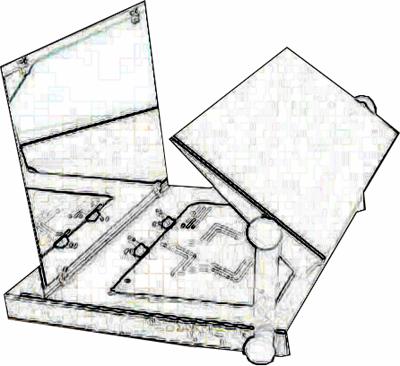 |

|
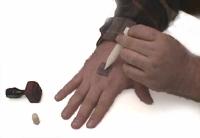 The
algisimeter is used to map the skin's responsiveness. By placing
the point gently on the surface of the skin, different nerve endings are
stimulated. The subject is asked to rate the sensation for strength
-- giving ratings of 0, 1 or 2.
The
algisimeter is used to map the skin's responsiveness. By placing
the point gently on the surface of the skin, different nerve endings are
stimulated. The subject is asked to rate the sensation for strength
-- giving ratings of 0, 1 or 2.
To maintain accuracy during placement, a grid stamp is available. You simply ink the stamp with washable ink and press it on the area of skin to be measured. To locate the grid accurately measure from a standard location such as the middle knuckle or a vein. I have data sheets in my office which makes recording the data easier.
Several weights
are available for the algisimeter. Simply unscrew the end weight
and add or remove additional weights.

This is a classic demonstration in the sensation of color. The motor can be adusted to rotate at different speeds to see the effect on the illusion.

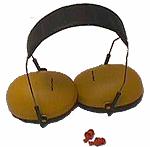 The
ear muffs and plugs will not provide absolute silence if there is a great
deal of noise in the environment. They are effective if the room
is already quiet. Students have used them in sensory deprivation
studies, attention studies, and modality studies.
The
ear muffs and plugs will not provide absolute silence if there is a great
deal of noise in the environment. They are effective if the room
is already quiet. Students have used them in sensory deprivation
studies, attention studies, and modality studies.
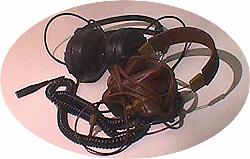 The
choice to use headphones or speakers for presenting auditory stimuli will
depend on the study. Headphones often increase the attention to the
stimuli and it is possible to separate the channels. The use of speakers
allows the subject to move freely. If you are using music as a variable
in your study, you may prefer to use speakers to provide background stimulation.
You might even wish to contrast the two methods.
The
choice to use headphones or speakers for presenting auditory stimuli will
depend on the study. Headphones often increase the attention to the
stimuli and it is possible to separate the channels. The use of speakers
allows the subject to move freely. If you are using music as a variable
in your study, you may prefer to use speakers to provide background stimulation.
You might even wish to contrast the two methods.

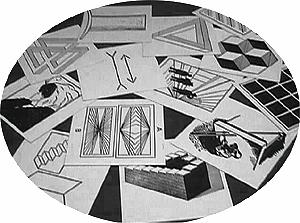 There
is a rich literature regarding illusions and the variables which influence
our perceptions. Some illusions are developmental - children don't
see them, but adults do. Some illusions are based on violations of
perspective. Still other illusions are the result of the way in which
our brains process information.
There
is a rich literature regarding illusions and the variables which influence
our perceptions. Some illusions are developmental - children don't
see them, but adults do. Some illusions are based on violations of
perspective. Still other illusions are the result of the way in which
our brains process information.
The illusion set includes the Necker Cube, the Poggendorf illusion, Horizontal-Vertical illusion, the Old Woman - Young Girl illusion, and of course the Mueller-Lyer Illusion.
If you are
interested in doing a study with illusions, we also have computer based
illusions and there are several sites on the Internet.

 trace
the pattern of a star as they look at it in a mirror. Some subjects
succeed easily, while other struggle to move their hand.
trace
the pattern of a star as they look at it in a mirror. Some subjects
succeed easily, while other struggle to move their hand.
This electronic
version of the mirror-tracer counts the number of times that the subject
goes out of the boundaries. Other measures which can be taken are
a) total time to complete the pattern, b) number of times paused, c) number
of reversals, d) miscellaneous verbal behavior. Further, you might
consider dividing the pattern into sectors to see if the behavior differs
from one area to the next.


In both tasks,
remember to carefully position the hand of each subject in the same way.
If you are going to let them rest their arm against the table, have all
subjects take the same position. Use the same type of pen for all
subjects. A ball-point with low resistance works best.

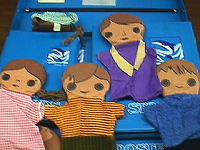 has
an array of large cards with pictures or words on them. There are
hundreds of these cards. Some of the sets also include dolls and
puppets.
has
an array of large cards with pictures or words on them. There are
hundreds of these cards. Some of the sets also include dolls and
puppets.
While many of the pictures are a little old-fashioned, most of them are suitable for use in verbal memory, recognition, and association tasks.
The advantage to using such graphics is that they are all drawn with the same style and complexity. Thus, subjects are not given additional cues to memory by the change of graphic style, size, and color palette. The words are also printed in a standard size and font.
If you are
only doing a word list, there are better materials available in the computer
programs section. If you are using the computer to present your materials,
graphics can be scanned to make small *.bmp files. You might also
look at collections of clip-art on the Internet, in WordPerfect and at
the Media Center.


The task was developed for industrial psychologists to test the ability to operate machines and equipment. There is a fairly large literature on such measures, although much of it will be found before 1980.
The star tracer
can be attached to the counter which will automatically record the number
of times the subject goes out of the lines. The counter can also
beep to tell the subject that they have made an error.

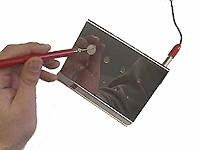 Just
as the Science Museum in Boston has a popular display centered on the mirror
tracer, the steadiness tester has a fascination for many people.
It measures both small-motor coordination and steadiness of the hand.
Many variables effect both, and the steadiness tester can be used as one
measure of stress, preparedness, and perhaps fitness.
Just
as the Science Museum in Boston has a popular display centered on the mirror
tracer, the steadiness tester has a fascination for many people.
It measures both small-motor coordination and steadiness of the hand.
Many variables effect both, and the steadiness tester can be used as one
measure of stress, preparedness, and perhaps fitness.
The subject is asked to place the stylus in each hole, starting with the largest. The counter can be attached to the stylus to automatically count the number of touches. In addition, you can record the total amount of time for the task, the amount of time for each hole, the amount of time between holes, or the smallest hole achieved without error.
You should
give standard instructions concerning the depth of placement, the amount
of time the stylus is to be held in the hole, and the placement of the
hands and arms. Some subjects might discover that holding the stylus
hand with their other hand greatly increases their skill level!

The subject is asked to start moving the stylus from the wider end to the narrower end. The counter can be attached to the stylus to automatically count the number of touches. In addition, you can record the total amount of time for the task, the distance at which the first error was made, or improvement across trials.
You can provide
audio feedback for your subjects on both the slot type and the hole type
steadiness testers. This feedback may either improve or detract from
performance.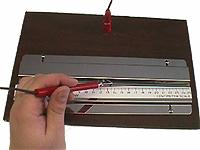
On this task,
it is better if the subject does not rest their arm on the table.
If they keep their arm in the same place, their hand will describe an arc
and it will harm their performance. If they move their arm along
the table, this could act as a guide for their hand and their performance
would be improved. Be careful to place the equipment parallel to
the subject and at the same distance from their elbow/shoulder. The
distance will vary depending on the height of the subject.

The tachistoscope attaches to a Kodak Ektagraphic slide projector. You sign out the slide projector from the equipment room at the Media Center. It might be best to take the tachistoscope with you so that you can be sure of getting the correct lens. You can then try it out to be sure of the controls.
I have several sets of slides which can be used as stimulus materials or the Media Center can make custom slides for your experiment. They have a complete price list at the front desk.
Pretest your settings before you begin your experiment. If you are doing verbal memory, you probably don't want to use 1/10th of a second -- the subject might not see it. If you are doing an experiment where the subject is to be influenced by surrounding stimuli, faster presentations might be in order.
You might test
a group of subjects at the same time. If the projector is placed
at the back of the room with the screen at the front, and subjects are
in the middle of the classroom, the differences in angle of view will be
minimal. Place your subjects at the same distance from the screen.

 When
I was in seventh grade, I saw a demonstration of the window illusion on
television. I decided then to become a psychologist. You never
know what kids are watching in TV!
When
I was in seventh grade, I saw a demonstration of the window illusion on
television. I decided then to become a psychologist. You never
know what kids are watching in TV!
The window
illusion demonstrates perspectival illusions. The window appears
to rotate, while in reality it is moving back and forth across a limited
arc. I am not sure if anyone will need it as equipment in an experiment,
but you might want to try it out for the fun of it.
